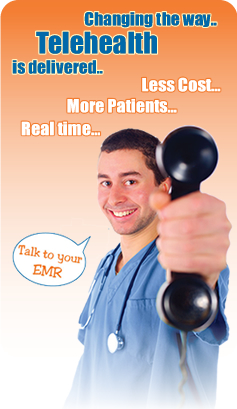
Q. What does it mean that HCI-Telehealth is a device-free-technology?
A. It means that there is no device brought to the patient home like in most home telehealth technologies available today. HomeCare Interactive Telehealth technology utilizes the home telephone or the patient cell phone as both input and output device between both the patient and his/her Electronic Medical Record.
Q. Do you use peripherals for vital signs such as blood pressure machines and glaucometers?
A. Yes, we do use wireless peripherals that has built blue tooth technology within them to facilitate transmission of patient physiological data to the electronic medical records, however we only recommend using those peripherals with limited number of patients who need them the most such as blind patients or those who have limitations to read and/or input the data through the phone. We recommend using off-the-shelf equipments of blood pressure, blood glucose, pulseoxymeter , etc...
Q. How long it takes to train a patient to use the HCI-Telehealth system?
A. If a patient has a phone then they already know how to use it. Very minimum time is involved to familiarize the patient with the system. We have introduced the system to 5 patients at once, not patient could answer the questions asked by the system. It is always less intimidating to the patient to use a familiar device such as the home phone.
Q. What is the meaning of patient information is exchanged in real time?
A. It means that while the patient is entering his or her information the Electronic Medical Record is capturing the values immediately, the system can then initiate different type of alerts such as Text messages, e mails and faxes to forwarded immodestly to every person assigned to receive such alert all occur before the patient hang up the phone with electronic medical record. It is important to note though that most systems that are used in the telehealth market today are store and forward. This means that information is only exchanged on a given time between the server and home device such as once or twice within 24 hours.
Q. Why don't you need a nurse to review the values coming from patients in the office?
A. If a patient value is out-of- range, the Electronic Medical Record will immediately recognize it the second it is inputted through the telephone and therefore alerted via several means to a care coordinator who may be dealing with the patient in the office or even the field. In this case, there would be no need for a reviewing nurse because every value is interrupted directly by the system.
Q. What if the call comes to the patient while not at home?
A. If a patient is out of the house, the call can be alternated to a another phone such as a relative phone or a cell phone.
Q. What if the patient could not answer the call at the scheduled time?
A. The system calls the patient several times with reasonable intervals until the patient answers. If the patient never answers the call, an alert message with be transmitted within a short time from the last attempt to notify the care coordinator if the lack of the patient information that were due at that time of the day.
Q. What if an answering machine answers instead of the patient?
A. If an answering machine answers instead of the patient, the system will call back until a live person answers and all values and questioned are answered.


